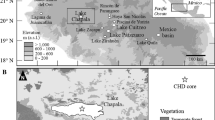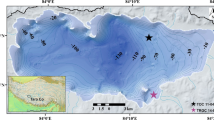Abstract
This paper reports on a high-resolution, multi-proxy, late-Holocene study from a lake in the Aspen Parkland of southern Alberta, Canada. A sediment core spanning the last 4000+ yrs from Pine Lake was analyzed for charcoal, granulometry, grain roundness, tephra content, geochemistry, mineralogy and pollen. This multi-proxy record indicates: (1) increasing anoxia causing a shift in S deposition from gypsum to pyrite due to increasing moisture availability in the late Holocene; (2) a decrease in Mg flux into the lake due to the development of the aspen forest, which reduced water flow through the Mg-rich shallow sand aquifer; the aspen forest expansion was in turn induced by the extirpation of plains bison prior to settlement; and (3) a change in the upland fire regime from frequent low-biomass grass fires to less frequent but higher biomass under-story fires, also as a result of the expansion of the aspen forest. Not only are the different proxies sensitive to different rates and magnitudes of change, they also show different sensitivities to different types of hydrological change: the mineralogy and geochemistry are sensitive to changes in water level and redox potential, and to changes in the relative strengths of the aquifers feeding the lake, while the granulometry is sensitive to total hydrological balance. Thus, apparently contradictory proxy results should be viewed as complementary.
Similar content being viewed by others
References
Blakney, S., 1998. Diatoms as Indicators of Eutrophication in Lakes, Pine Lake, Alberta, Canada: a Case Study. Unpublished M.Sc. thesis, University of Alberta, 112 pp.
Campbell, C., 1998. Late Holocene lake sedimentology and climate change in southern Alberta, Canada. Quat. Res. 49: 96–101.
Campbell, C. & I. A. Campbell, 1997. Calibration, review and geomorphic implications of postglacial radiocarbon ages in southeastern Alberta, Canada. Quat. Res. 47: 37–44.
Campbell, C., I. D. Campbell, C. B. Blyth & J. H. McAndrews, 1994. Bison extirpation may have caused aspen expansion in western Canada. Ecography 17: 360–362.
Campbell, I. D., 1994. Power function for interpolating dates in recent sediment. J. Paleolim. 15: 107–110.
Campbell, I. D. & C. Campbell, in press. Late Holocene vegetation and fire history at the southern boreal forest margin in Alberta, Canada. Paleogeogr. Palaeoclimatol. Palaeoecol.
Campbell, I. D., C. Campbell, M. J. Apps, N. W. Rutter & A. B. G. Bush, 1998. Late Holocene ~ 1500 yr climatic periodicities and their implications. Geology 26: 471–473.
Campbell, I. D. & M. D. Flannigan, in press. Long-term perspectives on fire-climate-vegetation relationships in the North American boreal forest. In: Stocks, B. J. & E. Kasischke (eds), Fire in Boreal Forests. Ecological Studies, Springer-Verlag, New York.
Clare, S., 1993. Pine Lake ground water study preliminary discussion. Unpublished report, Alberta Environment, Edmonton, 3 pp.
Crosby, J. M., 1990. Pine Lake. In Mitchell, P. & E. Prepas (eds), Atlas of Alberta Lakes, University of Alberta Press, 538–542.
Crowe, A. S., 1993. The application of a coupled water-balancesalinity model to evaluate the sensitivity of a lake dominated by groundwater to climatic variability. J. Hydrol. 141: 33–73.
Dean, W. E., 1974. Determination of carbonate and organic matter in calcareous sediments and sedimentary matter by loss on ignition: comparison with other methods. J. Sed. Petrol. 44: 242–248.
Downes, H., 1985. Evidence for magma heterogeneity in the White River Ash (Yukon Territory). Can. J. Earth Sci. 22: 929–934.
Elnora History Committee, 1972. Buried treasures. The history of Elnora, Pine-Lake and Huxley. Elnora History Committee, Elnora, 324 pp.
Faegri, K. & J. Iversen, 1989. Textbook of pollen analysis, 4th edition (revised by K. Faegri, P. E. Kaland & K. Krzywinski), John Wiley & Sons, Chichester, 328 pp.
Goldsmith, J. R. & D. L. Graf, 1958. Relation between lattice constants and composition of the Ca-Mg carbonates. Am. Mineralogist 43: 84–101.
Haig, B., 1990. A look at Peter Fidler's journal, Journal of a Journey Overland From Buckingham House to the Rocky Mountains in 1792 & 1793, Historical Research Centre, Lethbridge, 102 pp.
Håkanson, L. & M. Jansson, 1983. Principles of lake sedimentation, Springer-Verlag, Berlin, 316 pp.
Hardy, R. & M. Tucker, 1988. X-ray powder diffraction of sediments. In Tucker, M. (ed.), Techniques in Sedimentology. Blackwell Scientific Publications, 191–228.
Hickman, M. & C. E. Schweger, 1993. Late glacial–early Holocene palaeosalinity in Alberta, Canada–climate implications. J. Palaeolim. 8: 149–161.
Hickman, M. & C. E. Schweger, 1995. The late Quaternary palaeoenvironmental history of a presently deep freshwater lake in east-central Alberta, Canada and palaeoclimate implications. Palaeogeogr. Palaeoclimatol. Palaeoecol. 123: 161–178.
Klug, H. P. & L. E. Alexander, 1974. X-ray Diffraction Procedures for Polycrystalline and Amorphous Materials. John Wiley and Sons, New York, 456 pp.
Laird, K. R., S. C. Fritz, E. C. Grimm & P. G. Mueller, 1996. Century-scale paleoclimatic reconstruction from Moon Lake, a closed-basin lake in the northern Great Plains. Limnol. Oceanogr. 41: 890–902.
Laird, L. D. & I. D. Campbell, in press. High resolution paleofire signals from Christina Lake, Alberta: a comparison of the charcoal signals extracted by two different methods. Paleogeogr. Palaeoclimatol. Palaeoecol.
Last, W. M., 1994. Paleohydrology of playas in the northern Great Plains: perspectives from Palliser's Triangle. In Rose, N. R. M. (ed.), Paleoclimate and Basin Evolution of Playa Systems. Geological Society of America Special Paper 289: 69–80.
Last, W. M. & D. J. Sauchyn, 1993. Mineralogy and lithostratigraphy of Harris Lake, southwestern Saskatchewan, Canada. J. Paleolim. 9: 23–29.
Last, W. M. & J. T. Teller, 1983. Holocene climate and hydrology of the Lake Manitoba basin. In Teller, J. T. & Clayton, L. (eds), Glacial lake Agassiz. Geological Association of Canada Paper 26. Geological Association of Canada, St. John's, 333–353.
Lichti-Federovich, S., 1970. The pollen stratigraphy of a dated section of late Pleistocene lake sediment from central Alberta. Can. J. Earth Sci. 7: 938–945.
Malo, B. A., 1977. Partial extraction of metals from aquatic sediments. Environ. Sci. Technol. 11: 277–282.
Marquart, R. G., 1986. µPDSM: Mainframe search/match on an IBM PC. Powder Diffraction 1: 34–36.
Mathewes, R. W. & J. A. Westgate, 1980. Bridge River tephra: revised distribution and significance for detecting old carbon errors in radiocarbon dates of limnic sediments in southern British Columbia. Can. J. Earth Sci. 17: 1454–1461.
McAndrews, J. H., 1988. Human disturbance of North American forests and grasslands: the fossil pollen record. In Huntley, B. & T. Webb III (eds), Vegetation History, Handbook of Vegetation Science, Vol. 7. Kluwer, Utrecht, 673–697.
Porter, S. C., L. D. Delorme & D. J. Sauchyn, 1999. The ostracod record from Harris Lake, southwestern Saskatchewan: 9200 years of local environmental change. J. Palaeolim. 21: 35–44.
Powers, M. C., 1953. A new roundness scale for sedimentary particles. J. Sed. Petrol. 23: 117–119.
Reasoner, M. A., 1986. An inexpensive, lightweight percussion core sampling system. Géogr. Phys. Quat. 40: 217–222.
Reasoner, M. A. & R. E. Healy, 1986. Identification and significance of tephras encountered in a core from Mary Lake, Yoho National Park, British Columbia. Can. J. Earth Sci. 23: 1991–1999.
Rhodes, A., 1998. The Holocene palaeoclimatic history of Pine Lake, Alberta. Unpublished M.Sc. thesis, University of Alberta, 82 pp.
Sarna-Wojcicki, A. M., C. E. Meyer, M. J. Woodward & P. L. Lamothe, 1981. Composition of air-fall ash erupted on May 18, May 25, June 12, July 22, and August 17. In Lipman, P. W. & D. R. Mullineaux (eds), The 1980 Eruption of Mt. St. Helens. U.S. Geological Survey Professional Paper 1250, pp. 667–681.
Sauchyn, D. J., 1997. Proxy records of postglacial climate in the Canadian Prairie Provinces: A guide to the literature and current research. Appendix 1. In Herrington, R., B. Johnson & F. Hunter (eds), The Canada Country Study Volume III: Climate Impacts and Adaptation. Environment Canada, Regina.
Sauchyn, M. A. & D. J. Sauchyn, 1991. A continuous record of Holocene pollen from Harris Lake, southwestern Saskatchewan, Canada. Palaeogeogr. Palaeoclimatol. Palaeogeogr. 87: 13–23.
Schultz, L. G., 1964. Quantitative interpretation of mineralogical composition from X-ray and chemical data for the Pierre Shale. United States Geological Survey Professional Paper 391-C, 68 pp.
Schweger, C. E. & M. Hickman, 1989. Holocene paleohydrology of central Alberta: testing the general-circulation model simulation. Can. J. Earth Sci. 26: 1826–1833.
Smith, H. W., R. Okazaki & C. R. Knowles, 1977. Electron microprobe data for tephra attributed to Glacier Peak, Washington. Quat. Res. 7: 197–202.
Sosiak, A. & D. Trew, 1996. Pine Lake Restoration project: Diagnostic Study (1992). Unpublished Report, Alberta Environmental Protection, 120 pp.
Strong, W. L., 1977. Pre-and post-settlement palynology of southern Alberta. Rev. Palaeobot. Palynol. 23: 373–387.
Stuiver, M. & P. J. Reimer, 1993. Extended 14C data base and revised CALIB 3.0 14C age calibration program. Radiocarbon 35: 215–230.
Swain, A. M., 1973. A history of fire and vegetation in northeastern Minnesota as recorded in lake sediments. Quat. Res. 3: 383–396.
Vance, R. E., A. B. Beaudoin & B. H. Lukman, 1995. The paleoecological record of 6K climate in the Canadian prairie provinces. Géogr. Phys. Quat. 49: 81–98.
Vance, R. E., J. J. Clague & R. W. Mathewes, 1993. Holocene paleohydrology of a hypersaline lake in southeastern Alberta. J. Paleolim. 8: 103–120.
Vance, R. E., R. W. Mathewes & J. J. Clague, 1992. 7000 year record of lake-level change on the northern Great Plains: A highresolution proxy of past climate. Geology 20: 879–882.
Westgate, J. A., 1977. Identification and significance of late Holocene tephra from Otter Creek, southern British Columbia, and localities in west-central Alberta. Can. J. Earth Sci. 14: 2593–2600.
Westgate, J. A. & M. E. Evans, 1978. Compositional variability of Glacier Peak tephra and its stratigraphic significance. Can. J. Earth Sci. 15: 1554–1567.
Westgate, J. A. & M. P. Gorton, 1981. Correlation techniques in tephra studies. In Self, S. & R. S. J. Sparks (eds), Tephra Studies. D. Reidel Publishing Co., 73–94
Westgate, J. A., D. W. W. Smith & M. Tomlinson, 1970. Late Quaternary tephra layers in southwestern Canada. In Early Man and Environments in Northwest North America. The University of Calgary Archaeological Association, Calgary, 13–33.
White, J. M. & G. Osborn, 1992. Evidence for a Mazama-like tephra deposited ca. 10 000 BP at Copper Lake, Banff National Park, Alberta. Can. J. Earth. Sci. 29: 52–62.
Wilson, S. E., J. P. Smol & D. J. Sauchyn, 1997. A Holocene paleosalinity diatom record from southwestern Saskatchewan: Harris Lake revisited. J. Paleolim. 17: 23–31.
Winkler, M. G., 1985. Charcoal analysis for paleoenvironmental interpretation: A chemical assay. Quat. Res. 23: 313–326.
Yansa, C. H., 1998. Holocene paleovegetation and paleohydrology of a prairie pothole in southern Saskatchewan, Canada. J. Paleolim. 19: 429–441.
Yu, Z. & E. Ito, 1999. Possible solar forcing of century-scale droughtfrequency in the northern Great Plains. Geology 27: 263–266.
Author information
Authors and Affiliations
Rights and permissions
About this article
Cite this article
Campbell, I., Last, W.M., Campbell, C. et al. The late Holocene paleohydrology of Pine Lake, Alberta: a multiproxy investigation. Journal of Paleolimnology 24, 427–441 (2000). https://doi.org/10.1023/A:1008155622656
Issue Date:
DOI: https://doi.org/10.1023/A:1008155622656




